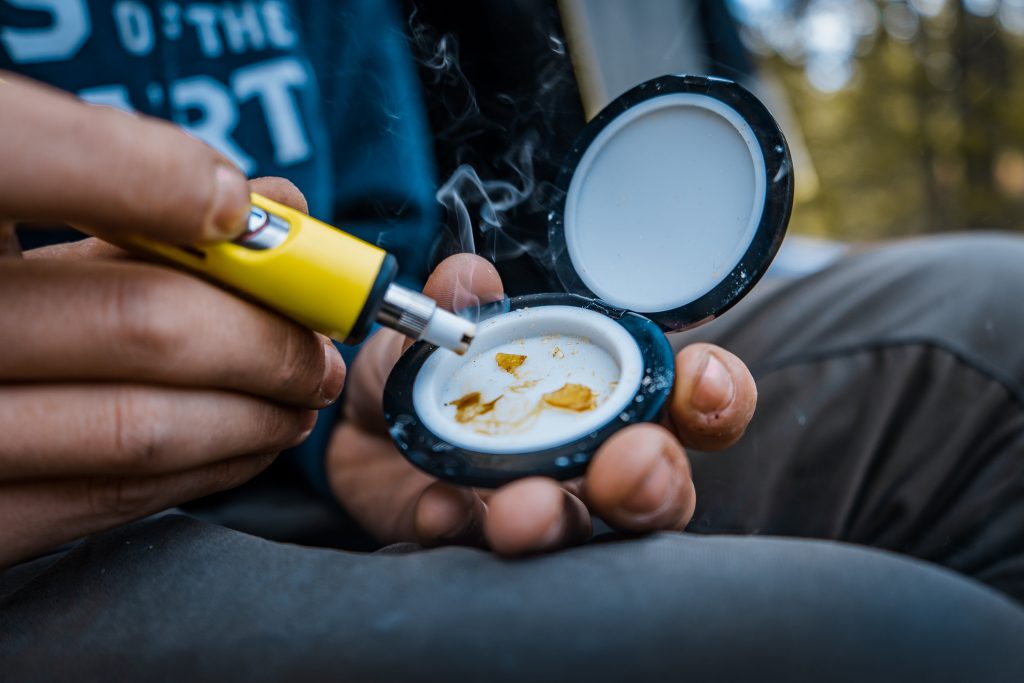Due to its great potency and rapid start of effects, cannabis concentrate has experienced a considerable increase in popularity in recent years. However, increased use carries the risk of addiction and dependence, which prompts people to seek out recovery treatment.
Rehabilitation provides a disciplined and encouraging environment where people can cleanse their bodies, participate in therapy, and learn critical coping skills. People who take part in recovery can get the assistance and resources they need to address the root reasons for their addiction, control cravings, and rebuild their lives without having to dab weed.
How long does it typically take you to complete your rehabilitation? Let’s find out.
How Long Does Dab Weed Stay in Your Body
THC is highly concentrated in dab weed. Those looking for a stronger, more immediate high are more and more likely to use this concentrated version of cannabis. The strength of dab cannabis, however, raises questions about addiction and its effects on the body.
The length of time that marijuana remains in your body can change depending on several variables, including how frequently you use it, how much you use, how quickly your metabolism works, and how much marijuana you use. THC can typically be found up to 30 days after consumption in urine, a few days in blood, and up to 90 days in hair follicles.
Rehab can help a person recover from addiction and live a healthy life again. While dab marijuana rehab specializes in addressing the problems brought on by concentrated cannabis usage, the length of treatment might change based on each patient’s needs and development.

What’s the Average Duration of Dab Weed Rehab
Program lengths for dab cannabis rehab might change based on client needs, development, and the particular treatment center. Here are some details on how long dab weed treatment lasts:
The Duration of Rehabilitation Varies for each Person
It’s crucial to understand that the length of rehab depends heavily on the individual and may differ greatly depending on the severity of the addiction, any co-occurring diseases, and the individual’s recovery. While some people may benefit from shorter rehab programs, others might need longer courses of therapy to address underlying problems and provide the groundwork for recovery.
Example Lengths of Typical Rehabilitation Programs
With certain modifications, dab cannabis addiction treatment programs typically last between 30 and 90 days. These periods are intended to be basic suggestions, therefore it’s important to speak with healthcare providers or addiction specialists to identify the best timeline for each person. Here are a few instances of typical rehabilitation program durations:
- 30-Day Program: This shorter program provides a concentrated, rigorous method of dab weed rehab. It gives people a strong foundation for recovery and gives them the necessary tools for preserving sobriety.
- 60-Day Program: A 60-day rehab program offers a more in-depth therapeutic experience, giving patients more time to address co-occurring illnesses, enhance relapse prevention techniques, and go deeper into therapy.
- 90-Day Program: People who have more serious dab weed addictions or who need more assistance and counseling over a longer length of time are sometimes advised to enroll in this long program. It permits a more thorough examination of underlying problems, the creation of long-lasting coping mechanisms, and more time for personal development.
Benefits of ongoing support and aftercare
No matter how long the first rehab program lasts, continued assistance and aftercare are essential for long-term rehabilitation. Programs for aftercare may include ongoing therapy sessions, involvement in support groups, and access to tools for preventing relapses.
It’s critical to keep in mind that rehabilitation is simply the beginning of a lifelong road toward recovery. To maintain sober and achieve positive long-term results, one must commit to continued assistance, practice self-care, and make use of the coping mechanisms they learned in treatment.
How Rehab Works for Dab Weed Addiction
The mental, physical, and emotional elements of addiction are all addressed during the systematic and thorough process of rehabilitation for substance misuse, including dab cannabis addiction. People might get a better idea of what to anticipate during their path to recovery by being aware of the general rehab procedure.
Detoxification
Detoxification, the initial phase of recovery, is to get rid of the toxins that dabbing weed use has left in the body. As their bodies become used to not having the drug, people may experience withdrawal symptoms during this phase. To ensure safety and offer the necessary assistance, medical personnel closely monitor the detoxification process.
Therapy
Following detoxification, many start therapy as a crucial step in their treatment process. Therapy aids people in comprehending the root causes of their addiction, creating coping mechanisms, and learning the skills required to keep sober. The psychological and emotional components of addiction are treated using a variety of therapeutic modalities, including private counseling, group therapy, and behavioral therapy.
Aftercare
After finishing the first rehab program, patients move on to the aftercare phase, which is concerned with continuing support and direction while they adjust to their regular life. Aftercare services can include a variety of methods, for instance, support groups and individual therapies will be there. The continuation of long-term healing and avoiding relapse depend on this phase.

Customized Treatment Plans
Like any substance abuse rehab, dab weed addiction treatment facilities should emphasize tailored treatment approaches. Since every person’s path through addiction and recovery is different, the rehab program must be customized to each patient’s needs if we want to achieve positive results. Here are some reasons why customized treatment strategies are essential in dab cannabis rehab:
- Personalized Approach: Personalized treatment plans consider each person’s particular requirements, circumstances, and objectives. The treatment program can be tailored to address the particular difficulties faced by people battling with dab weed addiction by considering things including the intensity of addiction, co-occurring mental health illnesses, and physical health conditions.
- Targeted Interventions: Each person’s root causes and triggers for dab cannabis addiction may vary. The treatment plan can directly target the particular causes causing the addiction by adding customized interventions, such as cognitive-behavioral therapy (CBT) or motivational interviewing (MI), which will result in more effective and specialized care.
- Holistic Care: A holistic approach to rehabilitation can be included in individualized treatment strategies in dab cannabis rehab. This calls for addressing both the addiction itself and the person’s general well-being. Long-lasting rehabilitation and a higher quality of life can be facilitated by including techniques for stress management, enhancing physical health, and encouraging self-care.
Marijuana treatment clinics can give people the instruments, support, and direction needed to beat addiction and lay a solid foundation for a better future by adopting a tailored treatment approach.
What are the Essential Factors Influencing Rehab Duration
Several elements that affect the healing process can affect how long dab weed recovery lasts for a given person. Individuals might have a reasonable idea of the time needed for successful rehabilitation by being aware of these elements. The following significant variables can impact how long rehab lasts:
Addiction or Dependence Severity
The length of recovery is significantly influenced by how severe the dab cannabis addiction or dependence is. People with more severe cases might need more time in treatment to address deeply ingrained addiction habits and acquire the skills required for long-term recovery. The length of rehab may be influenced by how severe the withdrawal symptoms are during detoxification.
Mental health disorders that co-occur
Co-occurring mental health conditions, including anxiety, depression, or post-traumatic stress disorder (PTSD), are common among people who struggle with dab cannabis addiction. Effective recovery depends on simultaneously treating fundamental mental health problems and substance abuse. Co-occurring disorders may cause the length of rehab to be increased because these complicated problems necessitate more therapeutic care and interventions.
Physical Health Problems
The time of dab cannabis rehab might be influenced by physical health difficulties. Chronic medical disorders, weakened immune systems, or other health issues can call for specific treatment and more recovery time. Sometimes, medical detoxification or continued care during rehab may be required, lengthening the total length of treatment.
Individual Development and Treatment Response
The length of rehabilitation may also depend on the progress and responsiveness of each individual to treatment. To actively participate in therapy, address underlying difficulties, and create efficient coping mechanisms, some people might need a longer time. Individualized timetables for rehab are the result of varying rates of progress through the various stages of therapy and reaching significant recovery milestones.
Support Systems
The length of recovery may also depend on the presence and quality of outside supports like family, sober living arrangements, and community services. After the official rehab program is over, a strong support network can continue to help.
It is significant to note that the length of rehab is not just influenced by time but also by each patient’s progress and adherence to specified treatment objectives. Treatment programs should be adaptable and flexible to meet people’s changing requirements as they progress through their recovery.
